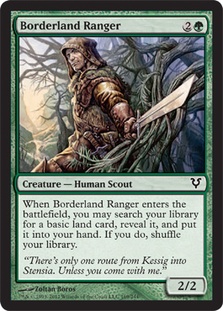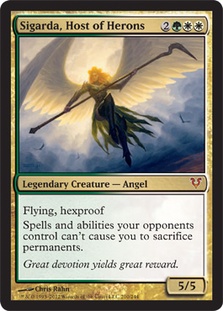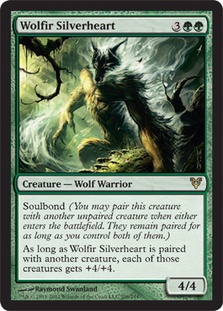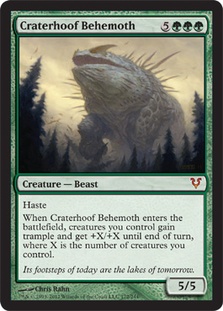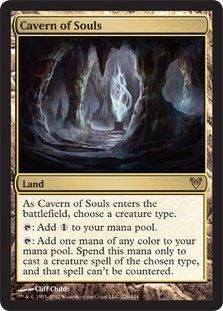It’s not just Avacyn Restored cards that will be joining the fray and shaking up Standard two weeks from now. Equally important are the older cards that will realize fresh potential because of the new set. Today I’d like to cover my personal favorite Magic card, Green Sun’s Zenith, which will be revitalized in a big way with Avacyn Restored’s premium selection of green creatures. I predict it to become a format-defining card like it’s never been before.
Of all places, it feels natural to start at the bottom of the mana curve.
Ulvenwald Tracker
Finally, a relevant threat to search for when X=1. Grim Lavamancer is a card I’ve been dying to play with in Standard, but maybe it was really Ulvenwald Tracker I was waiting for. Like Lavamancer, Ulvenwald Tracker requires only a one-mana investment and demands an answer lest it take over the game against an opposing creature deck. In many cases, though, Ulvenwald Tracker can be both more reliable and more powerful.
Grim Lavamancer, in a Standard format without fetchlands, can have a hard time finding fuel for even two or three activations over the course of a game, let alone one every turn. What’s worse is it’s unrealistic to ever support multiples, which means that when Lavamancer sees play, its typically in just two copies with the hope that he shows up when he’s useful and stays home when he’s not. That, combined with his vulnerability to removal, makes it impossible to build a deck around him or to lean on him heavily in any way.
Simply shifting the color of your one-drop’s border from red to green, however, changes everything. Four copies of Green Sun’s Zenith mean that you’ll have access to Ulvenwald Tracker in most of the games that you want him, even without devoting more than a single slot. Naturally, having other creatures in play to fight is as stiff a requirement as having cards in your graveyard, but any deck that supports Green Sun’s Zenith is likely to have no problem with that.
The two-mana requirement to activate the Tracker could become an issue when you consider the possibility of your creature being killed in response. When you activate the Trapper targeting your Kindercatch and your opponent’s Delver of Secrets, your opponent could have a Doom Blade or—dare I say it?—a Vapor Snag! If your opponent does, the two mana you invested may prevent you from replaying your creature or otherwise advancing your board in the ideal way.
This is why I suggest combining Ulvenwald Tracker with hexproof creatures like Dungrove Elder, Thrun, the Last Troll, and Sigarda, Host of Herons. Each of those creatures, especially Dungrove Elder, has remarkably high combat stats for their spot on the mana curve and can brawl with opposing creatures at little risk.
One could argue that Ulvenwald Tracker himself is simply a lightning rod for removal, and they’d be right. However, he’s likely to be played alongside Llanowar Elves and Birds of Paradise anyway, so Gut Shots and Galvanic Blasts will be put to good use whether you include the Tracker or not; it’s not as though he’s costing you much or turning on removal that would otherwise be dead.
There’s one last reason why I love Ulvenwald Tracker: it’s an interaction that I’m convinced will be quite important and will constitute much of the card’s value. Ulvenwald Tracker, with no risk of removal in response and even with no other creatures in play, kills Phantasmal Images at no cost. These days, Phantasmal Image is the scariest card for green creature decks, and having a way to mitigate its damage will go a long way.
All in all, I can see Ulvenwald Tracker doing a lot of what we want out of Daybreak Ranger at a cheaper cost and without a second color. With Delver this popular, though, I could still see wanting access to both in a Green Sun’s Zenith deck.
And all that’s just Standard! Look for Ulvenwald Tracker to combine with Tarmogoyf and Knight of the Reliquary in Legacy, especially for G/W Maverick mirrors.
Champion of Lambholt
I don’t consider Champion of Lambholt a great card in the abstract because it’s unimpressive against the many decks that have no interest in blocking. However, like Ulvenwald Tracker, he could be a powerful tool in certain types of creature mirrors. And that’s the beauty of Green Sun’s Zenith; it allows you to have the perfect tool for every job!
Are you tired of people holding you off with Huntmaster of the Fells and Lingering Souls? I know I am! What’s more, those people have come to feel overly safe and secure behind their defenses of token chump blockers. Searching up a Champion of Lambholt and growing him even once or twice can be a surprise that your opponents are unprepared for. Note that he doesn’t even need to attack himself in order to offer his ability.
In today’s Standard, the dominance of U/W Delver and the nature of its creatures discourages people from trying to block at all. However, at some point down the road we’ll see matchups where combat is important; we’ll see people playing with walls again; we’ll see less mass removal and more toe-to-toe battles. Champion of Lambholt is definitely a creature to keep in mind for the future.
Wolfir Avenger
Not especially interesting as a Green Sun’s Zenith target, but an all-around solid creature that might be your pick for a three-drop beatdown slot in certain decks or metagames. I especially like how much control flash gives you over your Werewolves flipping back and forth.
Borderland Ranger
I’m pleased to welcome back an old friend, though Borderland Ranger has not yet met Green Sun’s Zenith or Birthing Pod in a Standard environment.
Borderland Ranger is the epitome of guaranteed value. He smooths out your draws, making sure you hit your future plays on time regardless of color requirements, and he gives you a 2/2 body out of the bargain. His effect on the game is modest and may sometimes be overlooked, but he’s a very good addition to many decks.
Add to that the option to Tutor for Borderland Ranger on those occasions where there’s a reason you really want to hit your next land drop or when you expect your creature to be killed anyway and simply want to extract value. Now you have a card that can significantly improve green midrange and ramp decks by simply including a single copy.
Somberwald Sage
We come to the most exciting of the new Green Sun’s Zenith targets! I happily played with Palladium Myr in my Wolf Run Ramp Pod deck, and to say that Somberwald Sage is an upgrade would be an understatement. Three mana! Colored mana! Green Sun’s Zenith target! What more could a ramp deck want for that spot on the curve?
You’ll forget all your troubles when you untap with a Somberwald Sage. You need not even make your land drop to cast a Titan (any one you like), and she makes even more extreme plays like Elesh Norn, Grand Cenobite or Vorinclex, Voice of Hunger quite realistic.
It’s a shame that she can’t power up a future Green Sun’s Zenith, but the fact is that any deck that makes use of Green Sun’s Zenith will have a string of creatures going up to five, six, or more mana. She’ll pull her weight no matter what.
Finally, we have the classic issue of fragility, which I have to admit is a much bigger problem than it is on a one-drop. However again, Somberwald Sage is likely to be played only after a Birds of Paradise has baited a Gut Shot or survived and revealed your opponent’s lack of removal.
Because of the issue of fragility, though, I view Somberwald Sage and Borderland Ranger as an inseparable pair to played as one copy each in Green Sun’s Zenith ramp decks. For the times where all you need is that small, guaranteed value, you can search up the safe and reliable Ranger. For the times when you need to take a risk or have reason to believe that your opponent is lacking removal, you can search for the high-risk, high-reward Sage. The two are good in the same types of decks and complement one another when you have the option to fetch up either.
Sigarda, Host of Herons
Never before has a single green mana symbol so dramatically changed the value of a card! Sigarda is one of many, many, many powerful five-drops available to white/green players in Standard. In all likelihood, she might not see play in three or four copies as a maindeck card. However, the ability to Green Sun’s Zenith for such a unique and powerful creature is a welcome addition for ramp decks or even as a curve topper in a more aggressive strategy.
In combination with Cavern of Souls, U/B Control in its current form has almost no chance of beating Sigarda. Black Sun’s Zenith and Ratchet Bomb are far too slow to answer her effectively, and she flies right over the heads of Grave Titan and Snapcaster Mage.
Wolfir Silverheart
A solid creature in his own right, but I particularly love the option to search for him when your opponent is tapped out to connect for a huge hit right away. In particular, he combos well with double strike and could be powerful in a W/G midrange deck featuring Silverblade Paladin and Mirran Crusader. Note that soulbond does not target, so he’s able to bond with a protection from green creature.
Soul of the Harvest
Each new Magic set is bound to have so many medium-quality green fatties that I typically gloss over them and never give them a second thought. Soul of the Harvest, though, caught my eye. In a world of Cavern of Souls, he could just be the heir to the soon-to-rotate Primeval Titan.
It’s hard to envision a deck built around Soul of the Harvest as long as Primeval Titan is around, simply because the guaranteed value from the Titan is so precious. However, in the absence of removal I could see Soul of the Harvest quickly outclassing Consecrated Sphinx in his effect on a game. It’s not even out of the question to set up casting Soul of the Harvest and another creature in the same turn to make sure you get your value even if the opponent answers him at sorcery speed.
This guy could be deadly when combined with Somberwald Sage or Elvish Archdruid.
Craterhoof Behemoth
Say what you will about his mana cost, but Craterhoof Behemoth will do a very nice job of winning games any time he comes into play. If nothing else, this looks like a simple, straightforward choice for an Elf Combo win condition in older formats. I’d also consider it for a Frites deck that plays both Unburial Rites and Lingering Souls. Beyond that, it’s not out of the realm of possibility that this could be used in some ambitious green creature decks. Perhaps it could be a finisher in a deck that utilizes Soul of the Harvest.
Creatures (21)
- 4 Solemn Simulacrum
- 4 Birds of Paradise
- 1 Acidic Slime
- 1 Borderland Ranger
- 4 Primeval Titan
- 2 Viridian Emissary
- 1 Elesh Norn, Grand Cenobite
- 1 Phyrexian Metamorph
- 1 Huntmaster of the Fells
- 1 Sigarda, Host of Herons
- 1 Somberwald Sage
Lands (26)
Spells (13)

Above is an updated list of an archetype I championed before Dark Ascension. Note that compared to today’s Naya Birthing Pod made popular by Brian Kibler, this is a distinct deck with a distinct strategy. I don’t care much for chip damage, which is why cards like Strangleroot Geist, Blade Splicer, and Hero of Bladehold—all-stars in more aggressive Birthing Pod decks—aren’t included. Instead, my goal is a traditional one: cast Primeval Titan and watch it win the game for me.
I used to struggle, from a deck construction standpoint, with the three-mana slot in my Birthing Pod chain. As I’ve mentioned, this deck is not equipped to take full advantage of the aggression of Blade Splicer, so I found myself trying to use Palladium Myr as a little Dark Ritual before I would sacrifice it the following turn. Somberwald Sage is a strict and dramatic upgrade, and Borderland Ranger is a welcome addition as well.
I’ve already covered the Green Sun’s Zenith targets, but the new addition I have not discussed is Cavern of Souls. The powerful land adds a much-appreciated defense against permission to a deck that’s only traditional weakness is permission. However, the land is not a no-brainer, and it comes at a cost.
For one thing, as far as spells are concerned Cavern of Souls is a colorless land, which means that a fully three-color deck containing Whipflare, Slagstorm, and Day of Judgment becomes much more ambitious. What’s more is this is not a tribal deck, so which creature type to name requires careful planning.
I would expect the most common creature type to name would be Giant, but there’s no rule that says you have to. Maybe it’s a game where you’ll lose if you can’t stick Elesh Norn, Grand Cenobite. If you need colored mana on a certain turn, weigh the pros and cons of naming an early-game creature type. If it looks like your opponent left up a counterspell, name Golem, cast your Solemn Simulacrum, and make him waste his turn. Perhaps you can play mind games by naming a creature type you don’t even have in your hand!
Compared to more traditional Wolf Run, my suggested decklist will struggle more with a turn 1 Delver. However, it has a smoother curve, higher density of threats, and more flexibility because of the added ways to pull creatures from your library. Beyond that, I always feel at peace when Day of Judgment is in my deck, and you’ll be glad you weren’t playing straight G/R the first time you Wrath away a Hero of Bladehold or Phyrexian Obliterator.



